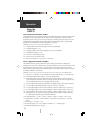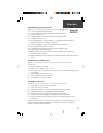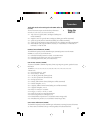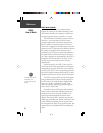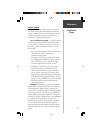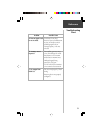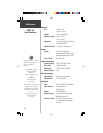
19
Reference
GPS:
How It Works
GPS: How It Works
The global positioning system is a satellite-based
navigation system consisting of a network of 24 orbiting
satellites that are twelve thousand miles in space and in
six different orbital paths. The satellites are constantly
moving and you can receive satellite signals anywhere in
the world, at any time.
The GPS signal contains a ‘pseudo-random code’,
ephemeris (pronounced: ee-fem-er-is) and almanac data.
This code identifies which satellite is transmitting—in
other words, an I.D. code. We refer to satellites by their
PRN (pseudo-random number), from 1 through 32.
Ephemeris data is constantly transmitted by each
satellite and contains important information such as status
of the satellite, current date, and time.
The almanac data tells the GPS receiver where each
GPS satellite should be at any time throughout the day.
Each satellite transmits almanac data showing the orbital
information for that satellite and for every other satellite
in the system.
Each satellite transmits a message which essentially
says, “I’m satellite #X, my position is currently Y, and this
message was sent at time Z.” Of course, this is a gross
oversimplification, but you get the idea. The GPS receiver
reads the message and saves the data for continual use.
Now, to determine your position the GPS receiver
compares the time a signal was transmitted by a satellite
with the time it was received by the GPS receiver. The
time difference tells the GPS receiver how far away that
particular satellite is. If we add distance measurements
from a few more satellites, we can determine our position.
This is what a GPS receiver does. With a minimum of
three or more satellites, your GPS receiver can determine
a latitude/longitude position—what’s called a 2D position
fix. With four or more satellites, a GPS receiver can
determine a 3D position which includes latitude,
longitude, and altitude. By continuously updating your
position, a GPS receiver can also accurately provide speed
and direction of travel.




